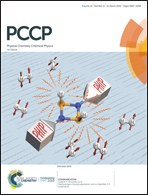Comparison of hydrogen vacancies in KDP and ADP crystals: a combination of density functional theory calculations and experiment
Abstract
The hydrogen vacancy (VH) is the most common point defect that may lead to optical damage of potassium dihydrogen phosphate (KDP) and its analog ammonium dihydrogen phosphate (ADP), further limiting their practical application in high-power laser systems. In this work, we have grown KDP and ADP crystals by using a rapid growth method, and investigated the physical origin of the different stability of VH as well as the defect-induced electronic structure and optical absorption in KDP and ADP crystals. The inclusion of van der Waals correction to density functional theory calculations is found to have little influence on VH energetics of KDP whereas it largely reduces the charge transition level ε(+/−) of VH by >2 eV in ADP. It is found that hydrogen vacancies mainly contribute to the redshift of the measured absorption edges of both KDP and ADP crystals. Owing to the varied lattice environments and locations, the VH defects exhibit different stability, and electronic and optical properties in KDP and ADP crystals. Notably, the extra optical absorption caused by the positively-charged VH in KDP could be largely reduced by decreasing the defect concentration, whereas ADP exhibits defect-location dependence – the optical damage center of the VH in the NH4+ group could not be eliminated because of electron capture of its neighboring N atoms. The calculation results help us to better understand the origin of laser damage in KDP and ADP crystals.



 Please wait while we load your content...
Please wait while we load your content...